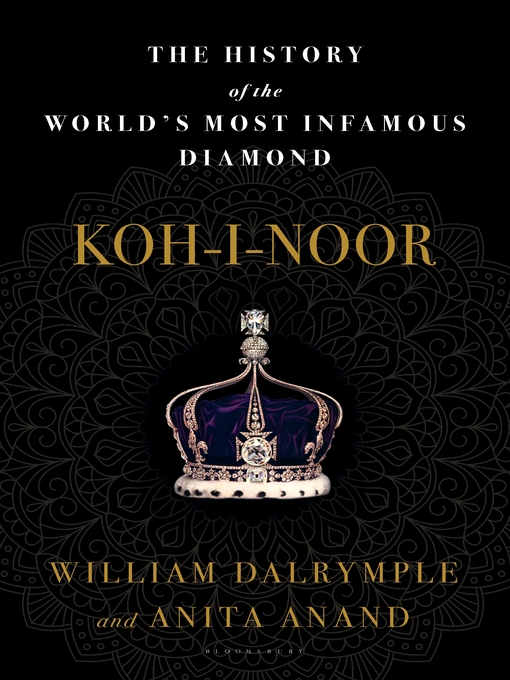- New eBook additions
- All About Education
- Cozy ebooks for Fall
- Made in West Virginia
- A Shore Thing
- First in the series
- Strange New Worlds
- Worlds of Fantasy
- Most popular
- Available now
- Try something different
- Just Plain Good
- See all ebooks collections
On March 29, 1849, the ten-year-old leader of the Sikh kingdom of the Punjab was ushered into the magnificent Mirrored Hall at the center of the British fort in Lahore, India. There, in a formal Act of Submission, the frightened but dignified child handed over to the British East India Company swathes of the richest land in India and the single most valuable object in the subcontinent: the celebrated Koh-i-Noor diamond, otherwise known as the Mountain of Light. To celebrate the acquisition, the British East India Company commissioned a history of the diamond woven together from the gossip of the Delhi Bazaars. From that moment forward, the Koh-i-Noor became the most famous and mythological diamond in history, with thousands of people coming to see it at the 1851 Great Exhibition and still more thousands repeating the largely fictitious account of its passage through history.
Using original eyewitness accounts and chronicles never before translated into English, Dalrymple and Anand trace the true history of the diamond and disperse the myths and fantastic tales that have long surrounded this awe-inspiring jewel. The resulting history of south and central Asia tells a true tale of greed, conquest, murder, torture, colonialism, and appropriation that shaped a continent and the Koh-i-Noor itself.
-
Creators
-
Publisher
-
Release date
September 12, 2017 -
Formats
-
Kindle Book
-
OverDrive Read
- ISBN: 9781635570779
- File size: 6959 KB
-
EPUB ebook
- ISBN: 9781635570779
- File size: 6959 KB
-
-
Languages
- English
-
Reviews
-
Publisher's Weekly
July 3, 2017
British historians Dalrymple (Return of a King) and Anand (Sophia: Princess, Suffragette, Revolutionary) trace the complicated, bloody, conflict-laden history of the Koh-I-Noor diamond in this winning account, following the diamond’s chain of ownership through the centuries. Drawing together firsthand accounts and historical documents, the authors attempt to nail down the famous diamond’s origins, starting with rumors and legends dating back to the 16th century. The gem is invariably linked to conquest, repeatedly passing hands from one ruler and country to another: from India’s Mughal dynasty to Nader Shah of Iran to Ahmad Khan Abdali of Afghanistan, then to the Sikhs and finally into the hands of the British Empire, where it remains today. This book is equally about those who have coveted and possessed the diamond as it is about the legendary stone; dynasties rise and fall, and rumors of a curse may be well-earned: “Its owners have variously been blinded, slow-poisoned, tortured to death, burned in oil, threatened with drowning, crowned with molten lead, assassinated by their own family and bodyguards, or have lost their kingdoms and died in penury.” It’s an eye-opening, informative, and entertainingly lurid narrative; the authors virtually revel in visceral details while highlighting the colonialism and appropriation so entwined with the diamond’s history. -
Kirkus
June 15, 2017
The tale of a diamond that became a coveted prize during centuries of political turmoil.The history of the Koh-i-Noor diamond is a narrative of greed, war, and barbaric cruelty. Dalrymple (Return of a King: The Battle for Afghanistan, 1839-42, 2013, etc.) and Anand (Sophia: Princess, Suffragette, Revolutionary, 2015) divide their chronology, with Dalrymple covering the gem's history from its mysterious origins in antiquity, when it was apparently removed from the eye of an idol in southern India, through medieval times, devastating conflicts in the 17th and 18th centuries, and ending in 1839, when India's ruler, and the gem's owner, Ranjit Singh, died. Anand picks up the story with Britain's increasing domination of India, the handing over of the diamond by Singh's son to the East India Company, its perilous transit to Queen Victoria, and its fate up to the present. The diamond was large but not the largest in the coffers of Asian rulers: an inch and a half long, nearly an inch wide, and shaped like an egg. It became a symbol of power, worn on ceremonial occasions, strapped to the bicep of whoever possessed it; the gem was coveted despite its reputation of having "dark powers." As Dalrymple writes, "few possessors of the Koh-i-Noor have led happy lives"--surely an understatement. "Its owners," he acknowledges, "have variously been blinded, slow-poisoned, tortured to death, burned in oil, threatened with drowning, crowned with molten lead, assassinated by their own family and bodyguards, or have lost their kingdoms and died in penury." The ship transporting the diamond to England was beset by cholera and a vicious storm. Although many who saw it described its amazing shine, viewers in England were disappointed when it was displayed at the Great Exhibition of 1851. Prince Albert contrived a new display case but eventually decided to have it cut. The result was a brilliant diamond half its original size. Currently, India, Pakistan, and the Taliban are zealously pressing for its return, which England staunchly refuses. A lively, well-researched history of lust for wealth and power.COPYRIGHT(2017) Kirkus Reviews, ALL RIGHTS RESERVED.
-
Loading
Why is availability limited?
×Availability can change throughout the month based on the library's budget. You can still place a hold on the title, and your hold will be automatically filled as soon as the title is available again.
The Kindle Book format for this title is not supported on:
×Read-along ebook
×The OverDrive Read format of this ebook has professional narration that plays while you read in your browser. Learn more here.


